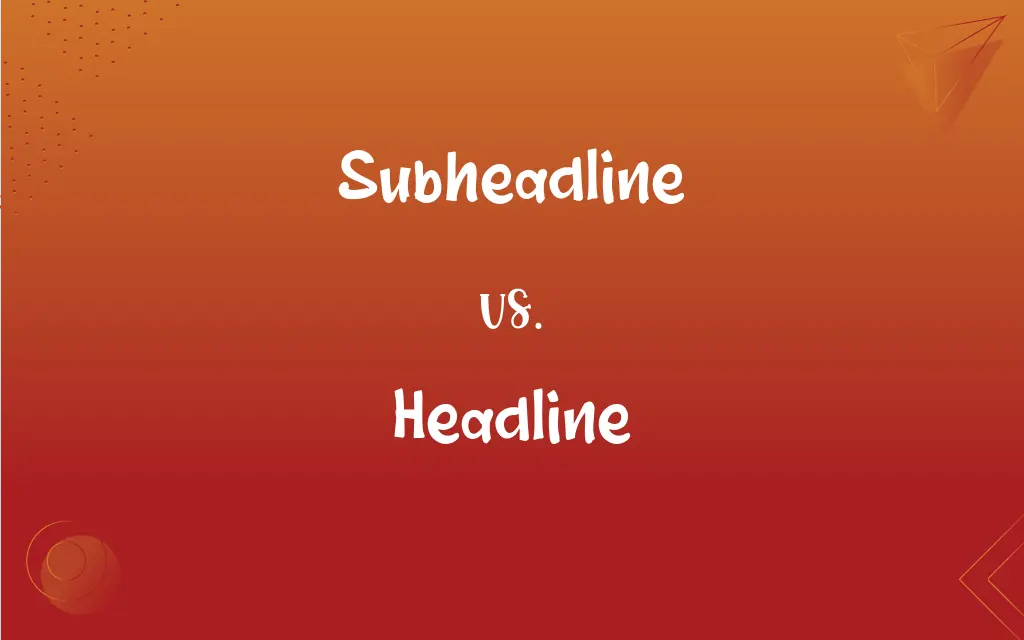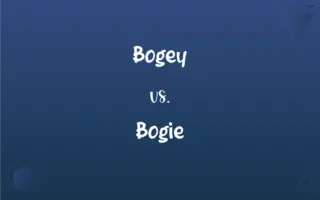Subheadline vs. Headline: What's the Difference?
By Harlon Moss & Aimie Carlson || Updated on May 23, 2024
A subheadline supports the main headline by providing additional detail or context, while a headline is the primary title meant to grab attention and summarize the main point of an article.

Key Differences
A headline is the primary title of an article, designed to catch the reader's eye and provide a snapshot of the content. It is typically bold and prominently placed at the top. The headline's main goal is to entice the reader to read further. A subheadline, on the other hand, serves as a secondary title that provides more context or detail to the main headline. It helps to elaborate on the headline's message, offering additional information that can further engage the reader.
In terms of placement, the headline is always positioned above the subheadline. The headline's primary function is to attract attention, whereas the subheadline supports this by clarifying or expanding upon the headline's point.
While a headline is concise and impactful, a subheadline can be slightly longer to give more detail. The headline captures the essence of the story, whereas the subheadline provides supplementary details to enhance understanding.
Headlines often use strong, action-oriented words to provoke curiosity, while subheadlines may use more descriptive language to provide clarity. Both are crucial in guiding the reader through the content.
In terms of design, headlines are usually in larger font sizes and may use bold or different colors, whereas subheadlines are in smaller fonts but still prominent enough to be noticed. This visual hierarchy helps in organizing the content effectively.
ADVERTISEMENT
Comparison Chart
Purpose
Grab attention and summarize main point
Provide additional detail or context
Placement
Above the subheadline
Below the headline
Length
Short and concise
Slightly longer for more detail
Language
Strong, action-oriented words
More descriptive for clarity
Design
Larger, bold font, sometimes colored
Smaller font, less emphasis but still noticeable
ADVERTISEMENT
Subheadline and Headline Definitions
Subheadline
The most prominent text on a page.
The headline was designed to be eye-catching and bold.
Headline
A supporting line under the main headline.
Readers often look to the subheadline for more information.
Subheadline
A title meant to draw readers in.
Effective headlines can significantly increase readership.
Headline
A secondary title giving more context.
The subheadline provided additional details about the event.
Subheadline
The leading statement in news articles.
The headline of the article was misleading.
Headline
An extended explanation following the headline.
The subheadline clarified what the article would discuss.
Subheadline
The main title of an article.
The headline on the front page captured everyone's attention.
Headline
A descriptive phrase supplementing the headline.
The subheadline elaborated on the main story.
Subheadline
A brief phrase summarizing the main point.
The headline succinctly conveyed the breaking news.
Headline
A secondary statement that expands on the headline.
The subheadline made the article's topic clearer.
Subheadline
A smaller, secondary headline that usually elaborates on the main headline above it.
Headline
The title or heading of an article, especially in a newspaper, usually set in large type.
Headline
Often headlines An important or sensational piece of news.
Headline
A line at the head of a page or passage giving information such as the title, author, and page number.
Headline
To supply (a page or passage) with a headline.
Headline
To present or promote as a headliner
The Palace Theater headlines a magician.
Headline
To serve as the headliner of
He headlines the bill.
Headline
(journalism) The heading or title of a magazine or newspaper article.
The headline on today's newspaper reads "John Doe Wins Wood-Splitting Competition."
Headline
The line at the top of a page containing the folio or number of the page.
Headline
(entertainment) The top-billed attraction.
Headline
(nautical) A headrope.
Headline
To give a headline to a page or section of a text.
Headline
To present as the main attraction; to have top billing, to be the main attraction.
Headline
The line at the head or top of a page.
Headline
See Headrope.
Headline
A title for an article in a newspaper, sometimes one line, sometimes more, set in larger and bolder type than the body of the article and indicating the subject matter or content of the article.
Headline
A similar title at the top of the newspaper indicating the most important story of the day; also, a title for an illustration or picture.
Headline
To mention in a headline.
Headline
To furnish with a headline (senses 1, 3, or 4).
Headline
To publicise prominently in an advertisement.
Headline
The heading or caption of a newspaper article
Headline
Publicize widely or highly, as if with a headline
Headline
Provide (a newspaper page or a story) with a headline
FAQs
How are headlines and subheadlines different?
Headlines are primary, concise, and attention-grabbing, while subheadlines offer more detail and context to support the headline.
Why are headlines important?
Headlines are important because they attract readers and give a quick summary of the article's content.
Why are subheadlines used?
Subheadlines are used to provide additional information that clarifies or expands on the headline's message.
What is a headline?
A headline is the main title of an article designed to catch the reader's attention and summarize the main point.
Do all articles have subheadlines?
Not all articles have subheadlines, but they are commonly used to provide extra detail.
What is a subheadline?
A subheadline is a secondary title that provides additional context or detail to support the main headline.
Can a subheadline stand alone?
No, a subheadline is meant to complement and provide context to a headline.
What is the typical length of a subheadline?
Subheadlines can be slightly longer than headlines, providing more detail in a few sentences.
Are headlines written in full sentences?
Headlines are often not full sentences but rather phrases that convey the main idea quickly.
Where are headlines placed?
Headlines are placed at the top of an article, above the subheadline.
Where are subheadlines placed?
Subheadlines are placed directly below the headline.
Can a subheadline be a question?
Yes, subheadlines can also be formatted as questions for further engagement.
What is the typical length of a headline?
Headlines are typically short and concise, usually no more than a few words.
Can a headline be a question?
Yes, headlines can be formatted as questions to provoke curiosity.
Are subheadlines written in full sentences?
Subheadlines are more likely to be full sentences to provide clear, detailed information.
What is the visual difference between a headline and a subheadline?
Headlines are usually in larger, bold font, while subheadlines are in smaller, less bold font.
Can the same text be both a headline and a subheadline?
No, the text should be distinct to serve their separate purposes.
Do headlines use strong verbs?
Yes, headlines often use strong, action-oriented verbs to grab attention.
Do subheadlines use descriptive language?
Yes, subheadlines use more descriptive language to add clarity and detail.
Do headlines and subheadlines follow specific writing guidelines?
Yes, both follow specific guidelines to ensure they are effective and engaging.
About Author
Written by
Harlon MossHarlon is a seasoned quality moderator and accomplished content writer for Difference Wiki. An alumnus of the prestigious University of California, he earned his degree in Computer Science. Leveraging his academic background, Harlon brings a meticulous and informed perspective to his work, ensuring content accuracy and excellence.
Co-written by
Aimie CarlsonAimie Carlson, holding a master's degree in English literature, is a fervent English language enthusiast. She lends her writing talents to Difference Wiki, a prominent website that specializes in comparisons, offering readers insightful analyses that both captivate and inform.































































